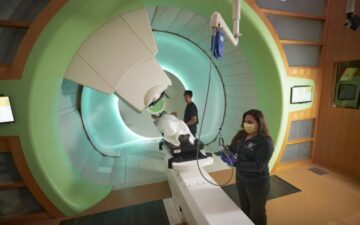
Travel to more than 350 astronomy meetings in 2019 resulted in the emission of 42 500 tonnes of carbon dioxide. That’s the conclusion of the first-ever study to examine the carbon emissions from travel to meetings by an entire field. The carbon cost amounts to about one tonne of carbon dioxide equivalent (tCO2e) per participant per meeting – roughly Africa’s average per capita carbon footprint in 2019 (1.2 tCO2e) (PNAS Nexus 3 pgae143).
Carried out by a team led by Andrea Gokus at Washington University in St. Louis in the US, the study examined 362 meetings in 2019 that were open to anyone in the astronomical community. These included conferences disseminating scientific findings as well as schools providing lectures and training to students and early-career scientists.
Using data on each participant’s home institutions that were available for 300 of the meetings, the researchers estimated travel-related emissions for each event, assuming delegates went by train or plane. For these meetings, the emissions totalled 38 000 tCO2e and a distance equivalent to travelling to the Sun and half way back.
For the other 62 meetings that did not have details of the participants’ home institutions, the team estimated the emissions using average data from other conferences. Emissions from those events were put at 4500 tCO2e, bringing the total to 42 500 tCO2e.
The meeting with the highest emissions per participant was Great Barriers in Planet Formation held in Palm Cove, Queensland in Australia, with almost all attendees traveling from outside the country. The travel from the 115 participants resulted in 461 tCO2e, or 4 tCO2e for every person, on average. The team found that emissions could have been more than halved if it had been held in Europe or the northeastern US.
Hub model
Gokus says that while meetings are important for researchers, “adjustments can be made to reduce their hefty carbon cost”, for example by knowing where participants are based. The researchers found, for example, that emissions from 2019’s biggest astronomical conference – the 223rd American Astronomical Society (AAS) meeting in Seattle – could have been cut by a quarter if it had been held in a more central US location.

Research infrastructures found to have an astronomical impact on astronomy’s carbon footprint
The team also explored the impact of switching the 223rd AAS meeting from a single-venue meeting to a hub model, in which simultaneous satellite events are held at different locations. A two-hub model for that conference, with an eastern and western US hub, would have reduced emissions by around 60%, the study finds. Adding a third European hub could have saved 65% of emissions, while a fourth hub in Asia, for instance in Tokyo, would have cut emissions by about 70%.
The researchers claim that such alternative meeting setups as well as virtual attendance, could have benefits beyond the environment. They point out that finances, complex visa processes, parenting and other careering responsibilities as well as disabilities can make travelling to meetings challenging for some.
“By making use of technology to connect virtually, we can foster a more inclusive collaborative approach, which can help us advance our understanding of the Universe further,” says Gokus. “It is important that we work together as a community to achieve this goal, because there is no Planet B.”
- SEO Powered Content & PR Distribution. Get Amplified Today.
- PlatoData.Network Vertical Generative Ai. Empower Yourself. Access Here.
- PlatoAiStream. Web3 Intelligence. Knowledge Amplified. Access Here.
- PlatoESG. Carbon, CleanTech, Energy, Environment, Solar, Waste Management. Access Here.
- PlatoHealth. Biotech and Clinical Trials Intelligence. Access Here.
- Source: https://physicsworld.com/a/astronomy-conference-travel-is-on-par-with-africas-per-capita-carbon-footprint/
- :is
- :not
- :where
- 000
- 1
- 2%
- 2019
- 300
- 350
- 362
- 4
- 42
- 4500
- 500
- 62
- 90
- a
- About
- Achieve
- adding
- advance
- airliner
- All
- almost
- also
- alternative
- American
- amounts
- an
- and
- anyone
- approach
- ARE
- around
- AS
- asia
- assuming
- astronomy
- At
- attendance
- attendees
- Australia
- available
- average
- b
- back
- barriers
- based
- BE
- because
- been
- benefits
- Beyond
- Biggest
- Bringing
- by
- CAN
- Capita
- carbon
- carbon dioxide
- carbon emissions
- carbon footprint
- central
- challenging
- claim
- Climate
- collaborative
- community
- complex
- conclusion
- Conference
- conferences
- Connect
- Cost
- could
- country
- courtesy
- Cove
- Cut
- data
- delegates
- details
- DID
- different
- disabilities
- distance
- each
- eastern
- emission
- Emissions
- Entire
- Environment
- Equivalent
- estimated
- Europe
- European
- Event
- events
- Every
- examine
- example
- Explored
- field
- Finances
- findings
- finds
- First
- first-ever
- Footprint
- For
- Foster
- found
- Fourth
- from
- further
- giant
- goal
- had
- Half
- halved
- Have
- hefty
- Held
- help
- highest
- Home
- HTTPS
- Hub
- if
- Impact
- important
- in
- included
- Inclusive
- information
- infrastructures
- instance
- institutions
- issue
- IT
- jpg
- Knowing
- landing
- lectures
- Led
- location
- locations
- Look
- Louis
- made
- make
- Making
- max-width
- meeting
- meetings
- model
- more
- no
- of
- on
- ONE
- open
- or
- Other
- our
- out
- outside
- palm
- Parenting
- participant
- participants
- per
- person
- Physics
- Physics World
- plane
- planet
- plato
- Plato Data Intelligence
- PlatoData
- Point
- processes
- Produced
- providing
- put
- Quarter
- reduce
- Reduced
- researchers
- responsibilities
- resulted
- roughly
- satellite
- saved
- says
- Schools
- scientific
- scientists
- simultaneous
- sky
- Society
- some
- st
- Students
- Study
- such
- Sun
- team
- Technology
- telescope
- than
- that
- The
- their
- There.
- These
- they
- Third
- this
- those
- thumbnail
- to
- together
- tokyo
- Total
- Train
- Training
- travel
- Traveling
- true
- understanding
- Universe
- university
- us
- use
- using
- Virtual
- virtually
- visa
- was
- washington
- Way..
- we
- WELL
- went
- were
- Western
- which
- while
- with
- Work
- work together
- world
- would
- zephyrnet












